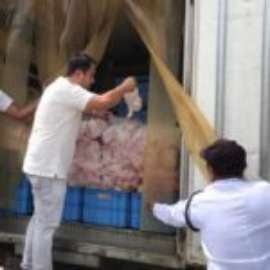









INTRODUCTION
The talisay city livestock & poultry center is located at lower mohon, talisay city, cebu. This slaughterhouse, confined in a 1.2971 hectares well-fenced land area is a city-owned facility built last December 2002 during the incumbency of Hon. Mayor Eduardo R. Gullas. It started serving the public on May 5, 2005. Its operation answers the fast growing demand for clean and healthy meat in the city. It has its own organizational structure, personnel, functions, objectives, rules and regulations to fully achieve the goals of the establishment pursuant to the City Ordinance No. 2005-17, otherwise known as the Slaughterhouse Ordinance of the City of Talisay.
Recognizing the intervention of modern equipment, semi-mechanized operation and well-maintained sanitation program in the abattoir, the National Meat Inspection Services (NMIS) granted the slaughterhouse a “AA” Accreditation and a “Good Manufacturing Practices” or “GMP” Certification which means that its meat products can be shifted and displayed for sale not only withing the City of Talisay but also anywhere in the Philippines.
It has been observed that the total number of food animals slaughtered daily in the slaughterhouse is rapidly increasing. This is an indication that the city is stronglt competing with its neighbouring cities and municipalities in terms of income gained. With this trend, there is a serious call to implement some strict measures to protect the consumer’s well-being. The slaughterhouse is attached to this call – to – produce healthy and clean meat for all consumers.
OPERATION
The Talisay City Livestock & Poultry Center is open twenty-four hours daily. The workers assigned in the operation are trained and experienced butchers, trained Meat Inspections and Livestock receivers. Others are assigned as Haulers, Entrails Cleaners, Scalers/Recorders, Checkers, Maintenance/Boiler Operators and Sanitation Personnel.
Permanent Employees as of September, 2022
Aguilar, Priscila
Agustin, Benjamin
Alipoyo, Dahlia
Bathan, Isagani Jr.
Cabiluna, Jesriel
Capala, Hector
Gesalan, Joselyn
Juarez, Gilbert
Magsayo, Jun Carlo
Supatan, Roldan
Villarias, Elmer
Normal operation starts on the following schedules:

Arrivals of hogs for slaughter usually start as early as 5:00am and will start to peak at 4:00pm until 9:00pm. Goats and large animal (Cattle, Carabao and sometimes horse) arrivals are from 2:00pm until 9:00pm.
The average numbers of food animals slaughtered daily in the slaughterhouse are estimated as follows:
Swing – 160 heads
Cattle – 50 Heads
Carabao – 20 Heads
Goat – 60 Heads
Production are at peak during the months of September up to January. During peak days such as Fiesta, Kalag-Kalag, Christmas, New Year, Sinulog and other days where there are celebration, schedules for operation are moved earlier.
Meat inspection is understood as professional investigation on the meat and entrails of slaughtered animals with reference to their fitness for human food. It is an important part of food hygiene. An effective meat inspection program must prevent the transmission of disease via carcasses, parts and meat products and must assure the consumer that meat supply is safe, wholesome and unadulterated. In broader sense, meat inspection also includes ante-mortem inspection and post-mortem inspection.
Objective of Meat Inspection
To produce wholesome meat for man.
To protect the consumers from eating diseased meat and meat products
To protect the consumer from financial loss through frauds and deceptions by causing meat which are not altogether objectionable under compulsory declaration.
To furnish valuable assistance to veterinary police work and hygiene.
In order to meet these meat inspection objectives, aside from the existing regular Meat Inspectors who satisfactorily completed the requirements of the Basic Meat Inspection Training Course (BMITC) conducted by the Department of Agriculture – National Meat Inspection Services office (DA-NMIS), additional personnel were given Special Order signed by the City Mayor for the designation of Meat Inspectors to help in the implementation of Meat Inspection within the city.
These designated Meat Inspectors together with the regular Meat Inspectors are assigned in anti-mortem and post-mortem inspection of animals and in the re-inspection of meat and meat products coming from places outside Talisay that are offered for sale in the local markets.
The Talisay City Slaughterhouse Meat Task Force was created for the implementation of Post Abattoir Operations within the city of Talisay. This group is composed of Meat Inspectors (both regular and designated) assigned in the slaughterhouse. The group leader (chosen from among the members) makes consultation with the City Veterinarian/Slaughterhouse Implementing officer and from time to time with the NMIS office, the Provincial Veterinary office and other agencies concerned for proper coordination.
Objectives of Post Abattoir Operation
1. To conduct surveillance on sites where reported illegal slaughter occur.
2. TO conduct re-inspection of meat on sale at public markets and supermarkets from time to time within the city.
3. TO check and conduct inspection on the quality of meat and meat products in cold storage facilities within the city.
4. To conduct surveillance on the compliance of “Meat Handler’s License and Price Tag Display” by meat vendors/stall owners during market inspection.
5. To conduct surveillance on the compliance of “Meat Inspection Certificated Display” by meat vendors/stall owners during meat and meat products inspection.
The meat task force can confiscate meat, meat products and carcasses during operation based on the following grounds.
1. Meat or meat products and carcasses showing signs of deterioration, adulteration and contamination due malpractice and poor hygienic handling.
2. Meat or meat products and carcasses with gross pathological lesions or clear manifestation of disease that warrant outright condemnation.
3. There is no accompanying Meat Inspection Certificates (MIC) and confirmed to be clandestinely slaughtered.
4. The accompanying MIC is found to be forged, falsified, counterfeited, or signed by unauthorized person.
5. Meat or meat products and carcasses transported outside the prescribed destination stipulated in the MIC.
6. Meat or meat products and carcasses bearing no signs of inspection mark or brand in the prescribed body parts or no leg band or bearing no seal or MIC Inspected and Passed Mark in the immediate container as in the case of poultry.
7. Meat or meat products and carcasses found to be mislabeled.
Violators are issued original copy of confiscation/Warning receipt for first offense and filing of appropriate charges for second and subsequent offenses base on (Administrative Order No. 5 and R.A. 7394 Consumer Act of the Philippines). The duplicate copy of the Confiscation receipt is kept for office file. The confiscated meats are brought to the nearest police station to be entered in the blotter.
The confiscated meats are then taken to the slaughterhouse compound to be condemns and thrown inside the condemnation chamber.
The Talisay City Livestock and Poultry Center, being “AA” accredited slaughterhouse must be compliant with “Good Manufacturing Practices” or simply GMP standard. As defined by the Food Development Authority (FDA), GMP is a must practice in the slaughtering and processing of meat to bring the safety and sanitary handling of foods. It includes the following requirements:
1. Personnel
2. Plant and Grounds
3. Sanitary Operations
4. Sanitary Facilities and Controls
5. Equipment and Utensils
6. Processes and Controls
7. Warehousing and Distributions
To be able to comply with these GMP requirements, a group later on named “GMP Team” composed of competent workers assigned in the slaughterhouse was formed. Members of this group do not only supervise the compliance of GMP by the workers inside the slaughterhouse buy they are also in charge in the preparation of documents and all other important requirements (see listed below) for the annual re-accreditation and GMP audit of the slaughterhouse (now done every three years).
